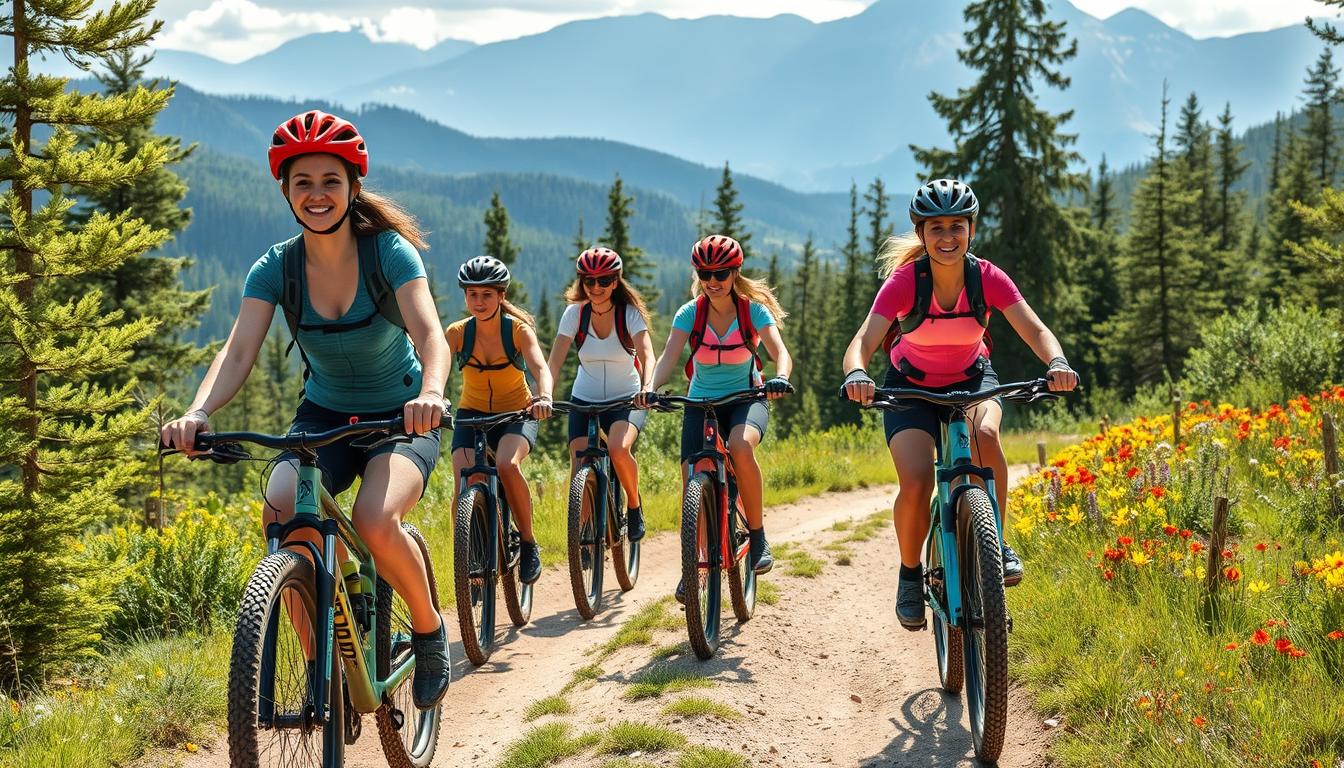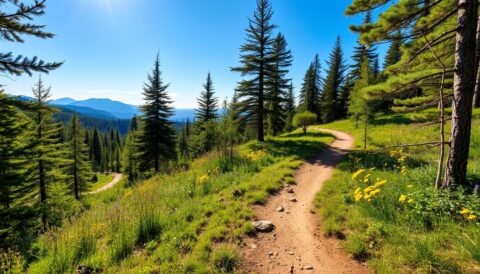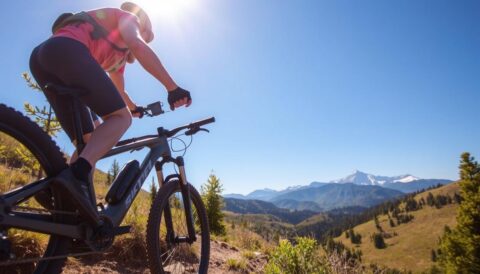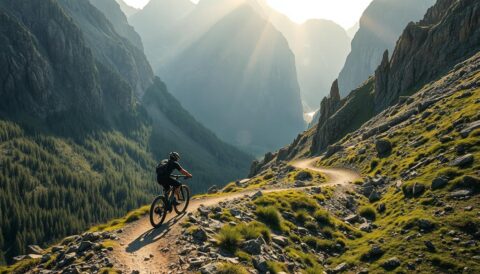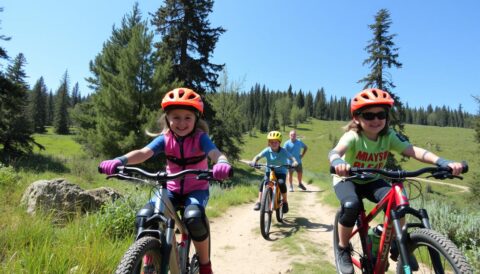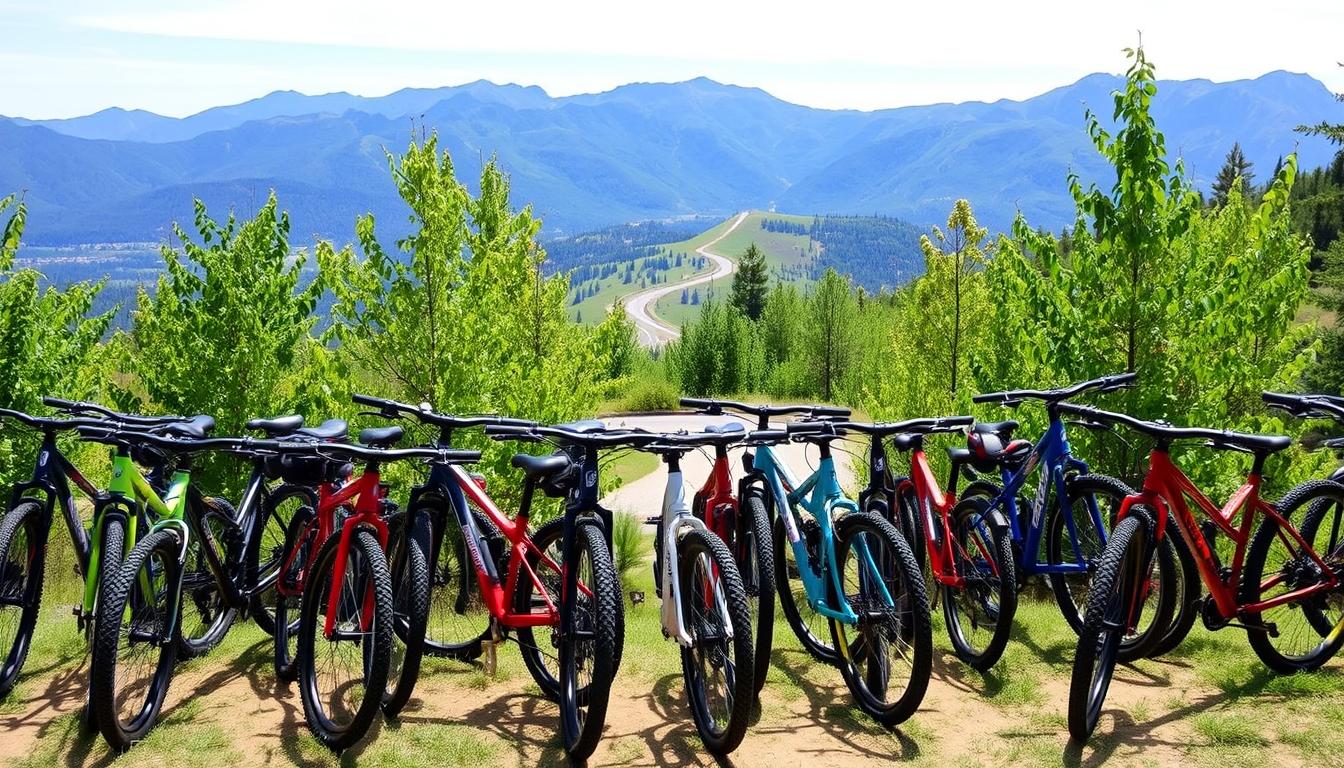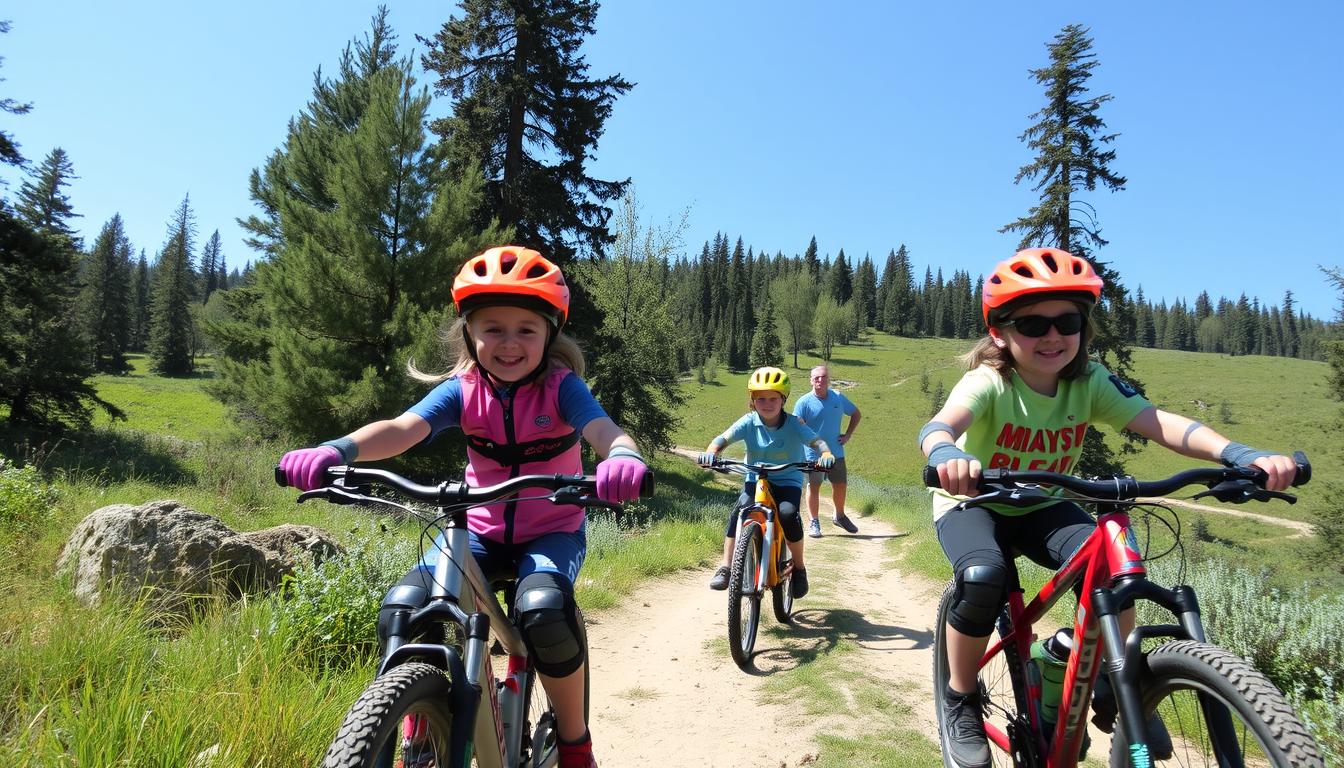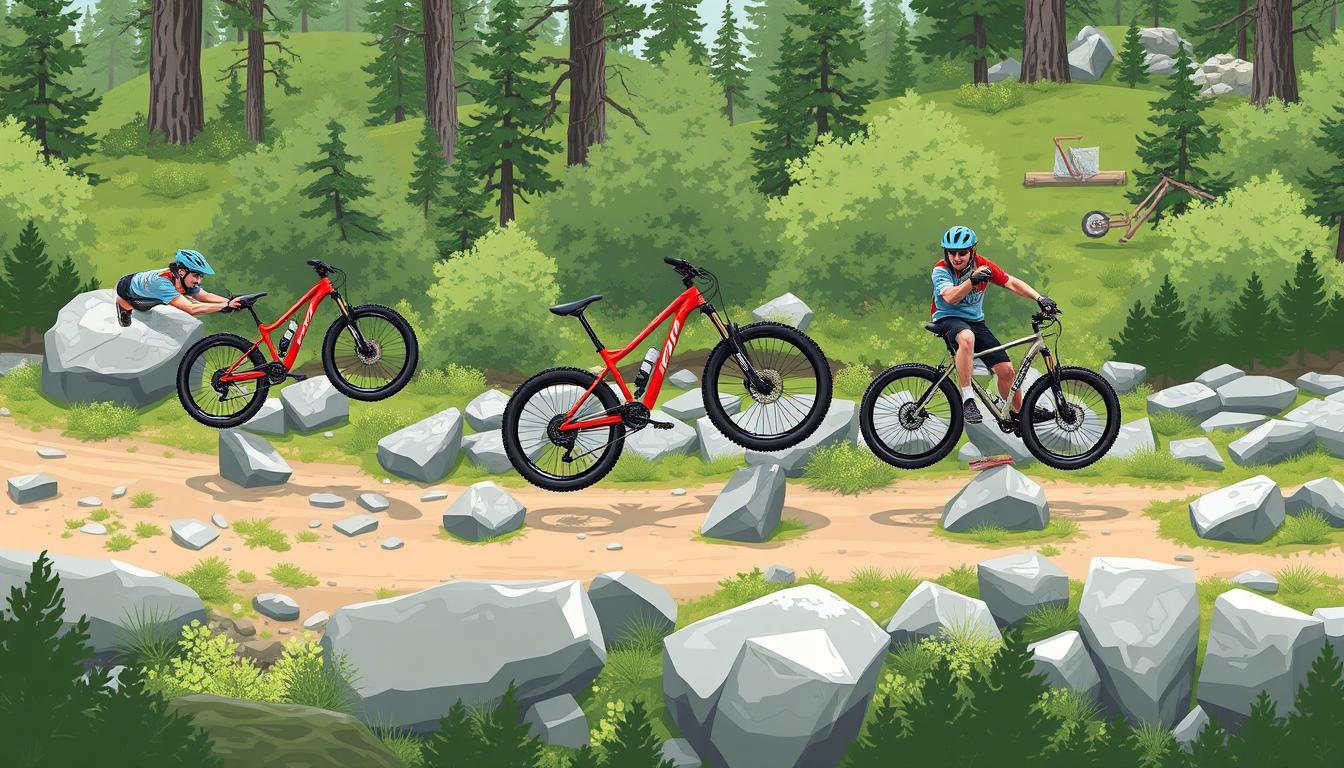Mountain biking offers an exhilarating outdoor adventure for women. It’s a growing sport, with females making up 20-25% of participants1. This presents an exciting opportunity for more women to join in.
Beginner mountain biking for women is far more welcoming than it may seem. The sport offers incredible flexibility, with trail difficulties ranging from gentle paths to challenging routes1. About 30% of trails are classified as easy, perfect for new riders1.
Comfort is crucial when starting out. About 60% of women prioritise bike comfort as their main consideration1. Modern manufacturers now create women-specific mountain bikes catering to female riders’ ergonomic needs1.
Approximately 80% of new female mountain bikers are keen on skill development clinics1. This shows a proactive approach to learning and improving.
Safety is paramount in mountain biking. About 70% of injuries relate to falls or obstacle collisions1. Proper protective gear and guidance from experienced riders can significantly reduce risks2.
Mountain biking offers an inclusive pathway for women of all skill levels. The key is starting small and embracing the learning journey. It’s a fantastic way to seek adventure, fitness, and outdoor passion.
Essential Gear and Equipment for Women Mountain Bikers
Proper gear is vital for safe and enjoyable mountain biking. Women’s mountain bike equipment ensures a comfortable ride. Choosing the right gear needn’t be daunting for new riders.
Choosing the Right Mountain Bike
The perfect mountain bike is crucial for riding success. Women’s-specific bikes offer tailored features for enhanced comfort and performance.
Key factors to consider when choosing your bike include:
- Frame geometry suited to women’s body proportions
- Appropriate bike size for your height
- Suspension that matches your riding style
- Comfortable saddle design
Essential Safety Gear and Protection
Safety should always be your top priority. A high-quality helmet is non-negotiable for mountain biking.
The Giro Women’s Montara MIPS helmet offers excellent protection for under £1003. Its MIPS technology reduces harmful forces to the brain during crashes3.
| Safety Item | Recommended Options | Price Range |
|---|---|---|
| Helmet | Giro Montara MIPS | Under £100 |
| Gloves | Fox Ranger Gloves | £20+ |
| Protective Eyewear | Impact-resistant cycling glasses | £30-£80 |
Proper Mountain Biking Attire
Comfort is key for mountain biking clothing. Women’s-specific gear offers better comfort and fit4.
Essential clothing items include:
- Padded bike shorts like Patagonia Nether Liner (£59)4
- Moisture-wicking tops
- Comfortable, sturdy mountain bike shoes
- Layered clothing for changing weather conditions
Pro Tip: Invest in gear that balances quality and comfort. You don’t need the most expensive equipment to enjoy mountain biking!
Most mountain biking accessories are not gender-specific4. Focus on finding gear that fits well and boosts your confidence on the trails.
Building Mental Confidence and Overcoming Fear
Mountain biking can be daunting for newcomers, especially on tricky trails. Mental prep is vital for conquering fear and boosting confidence5. Most bikers face anxiety-inducing obstacles, but mastering these feelings is crucial for enjoyment5.
“Confidence comes from preparation and practice, not from wishful thinking.”
Developing mental resilience involves several strategic approaches:
- Start with attainable trails that match your skill level6
- Practice visualization techniques to boost performance5
- Ride with supportive companions who can provide encouragement6
Studies show 85% of riders feel more confident when riding with an experienced partner. Professional coaching can boost skill growth by 50%, especially for women new to biking5.
| Mental Preparation Strategy | Success Rate |
|---|---|
| Visualization Techniques | 60% |
| Riding with Supportive Partner | 85% |
| Professional Coaching | 50% |
Adopting a growth mindset is crucial. Top athletes like Katy Curd stress that fear is normal at all levels6.
Remember the “rule of three”: if you can’t conquer a feature in three tries, it’s fine to walk away6. This helps maintain your mental focus.
Use these mental prep strategies to build confidence gradually. Soon, you’ll be revelling in the thrilling world of mountain biking7.
Understanding Different Trail Types and Terrain
Mountain biking offers thrilling adventures across diverse terrains. Knowing trail types helps riders pick routes matching their skills. This knowledge boosts confidence and enjoyment on the trails89.
Trail classifications guide riders through mountain bike ratings. These ratings help bikers understand what to expect on different trails.
Trail Type Overview
- Singletrack: Narrow trails between 6-24 inches wide, designed for one-way traffic8
- Doubletrack: Wider paths allowing side-by-side riding9
- Fire Roads: Graded dirt roads typically used for emergency vehicle access8
Trail Difficulty Ratings
| Difficulty Level | Characteristics | Trail Width | Obstacle Height |
|---|---|---|---|
| Easy (Green) | Beginner-friendly | 36+ inches | Less than 2 inches |
| Intermediate (Blue) | Moderate challenge | 24+ inches | Up to 8 inches |
| Difficult (Black) | Advanced terrain | 12+ inches | Up to 15 inches |
Reading Trail Features
Trail features include berms, roots, drop-offs, and technical obstacles. Slickrock trails offer unique rides with great traction on sandstone89.
Pro tip: Local bike shops and mountain biking apps are excellent resources for finding and understanding trail conditions8.
Grasping mountain bike trail ratings helps riders tackle terrain challenges safely. This knowledge allows bikers to progress confidently through different trails.
Beginner Mountain Biking for Women: Core Skills to Master
Mastering basic mountain biking skills is crucial for women starting their off-road cycling journey. The right techniques can turn an intimidating experience into an exhilarating adventure10. Each year, about nine million people enjoy off-road riding10.
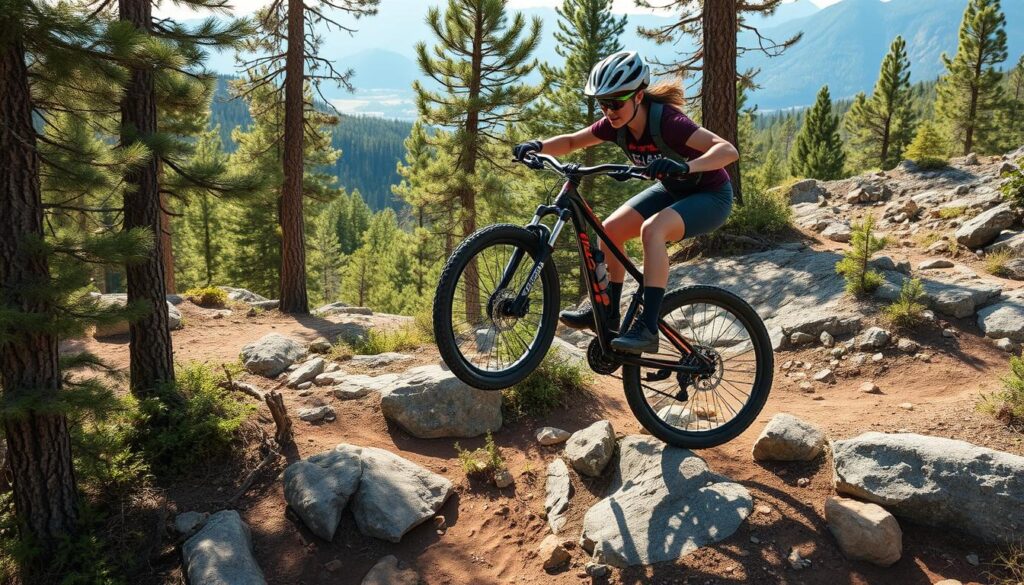
Let’s explore the core skills every new mountain biker should develop:
- Body Positioning: Learn to distribute your weight correctly for balance and control
- Braking Techniques: Understand how to use both front and rear brakes effectively
- Gear Shifting: Practice smooth transitions for efficient pedalling
Body positioning is key in mountain biking. Shift your weight forward when climbing and back when descending for stability11.
Cross-country trails are ideal for practising basic skills. They typically have mild grades and fewer technical challenges11.
“Practice makes perfect – start in open areas before hitting challenging trails”
Safety is crucial in mountain biking. About 66% of beginners crash in their first year11. However, this risk drops with proper skill development.
Women’s mountain biking clinics often have small group ratios. They usually maintain a 1:6 ratio for personalised instruction10.
Recommended practice locations include:
- Empty car parks
- Flat grassy areas
- Beginner-friendly trails
By focusing on these core skills, women can build confidence. They’ll soon enjoy the incredible world of mountain biking10.
Finding Your Mountain Biking Community
Women’s mountain biking groups can turn solo rides into thrilling shared adventures. These communities support and inspire new riders, making the experience more enjoyable12.
Women-Specific Riding Groups
Women’s mountain biking groups offer a welcoming space for beginners. Here, riders can build confidence and skills without feeling intimidated13.
- Meetup.com hosts 93 global women’s mountain biking groups with 61,580 members13
- Local bike shops frequently organise women-specific rides13
- Skill development camps like Trek Dirt Series offer targeted training13
Local Biking Organisations
Local cycling groups connect riders and create opportunities for shared experiences. The International Mountain Bicycling Association (IMBA) believes that “Everyone deserves a place to ride”13.
Social Media Communities
Online platforms have changed how women find mountain biking communities. Facebook pages, forums, and online groups help riders connect with like-minded enthusiasts12.
Joining a community isn’t just about riding—it’s about building confidence, sharing experiences, and growing together.
Mountain biking becomes more rewarding when shared with others. These connections help you overcome challenges and celebrate your progress12.
Essential Trail Riding Techniques
Mastering mountain bike trail techniques takes time and effort. Beginners must grasp core trail strategies to develop their skills. Learning to read trails and maintain momentum is crucial14.
Key mountain bike trail techniques for beginners include:
- Maintaining the attack position for stability14
- Practicing line reading on different terrains14
- Understanding proper braking techniques14
Visual focus is vital when navigating trails. Your bike follows where you look. Look ahead and plan your route14.
Start practising on smoother surfaces. Gradually progress to more challenging trails14.
Remember: “Your bike goes where your eyes go” – a fundamental principle in mountain bike trail techniques.
Gear management is a crucial skill to master. Shift gears before climbing to protect your bike’s drivetrain15. Many new riders struggle with gear shifting.
Practice is key. About 60% of beginners improve by watching videos and practising regularly15.
Advanced riding skills for beginners include:
- Track standing for balance control15
- Suspension engagement techniques15
- Mental preparation and breathing exercises15
Learning mountain bike trail techniques can be daunting. Remember, every expert started where you are now. Consistent practice and patience will boost your trail confidence1415.
Nutrition and Hydration on the Trail
Mountain biking requires specific nutrition to keep you at your best. Fuelling your body properly is vital for tackling tough terrain and long rides16.
What to Pack for Different Ride Lengths
Your food choices should match your ride length. Short trails need light, energy-rich snacks. Longer trips call for more detailed meal planning16.
- Short rides (1-2 hours):
- Energy bars
- Dried fruit
- Nuts
- Longer rides (3-6 hours):
- Protein-rich snacks
- Electrolyte supplements
- Comprehensive meal replacements
Energy Management Tips
Steady energy levels are key for mountain biking success. Try to eat about 30g of carbs every hour during rides17.
Whole-food carbs give you more stable energy than refined options16.
“Fuel your ride, not just your body” – Mountain Biking Nutrition Mantra
Hydration Essentials
Staying hydrated is crucial for mountain biking. Losing just 2-3% of body weight through sweat can hurt your performance17.
Aim to drink about 750 mL of fluid each hour during your ride17.
| Hydration Stage | Fluid Intake |
|---|---|
| Pre-Ride (2 hours before) | 12 ounces |
| During Ride | 750 mL per hour |
Pro tip: Create a personalised hydration strategy based on your individual sweat rate and ride conditions.
Conclusion
Mountain biking offers an exciting path to personal growth and outdoor exploration. Women can embrace a transformative experience that blends physical challenges with mental resilience. The sport’s community has grown, welcoming riders of all skill levels18.
Understanding trail dynamics is vital for women in mountain biking. Beginners should start with green trails to develop core skills. Proper equipment and technique are essential for a safe, enjoyable ride19.
Your journey involves more than just technical skills. It’s about joining a supportive community. Brands like Liv and Trek now design bikes tailored to women’s needs18.
Embrace the challenge and prioritise learning. Remember, every expert rider started where you are now. Mountain biking offers a chance to test yourself and connect with nature.
This sport provides a life-changing experience that goes beyond the trail. It’s an opportunity to discover inner strength and seek adventure.
FAQ
Is mountain biking suitable for women with no prior cycling experience?
Mountain biking welcomes women of all skill levels. Beginners can start with gentle green trails. Gradually build confidence and skills by learning fundamental techniques in a supportive environment.
Invest in proper equipment and begin slowly. This approach ensures a safe and enjoyable experience for newcomers.
How expensive is it to get started in mountain biking?
Starting mountain biking doesn’t require a fortune. Entry-level bikes cost around £300-£600, and many shops offer rentals. Essential safety gear is relatively affordable.
You can build your kit gradually as you become more involved. This allows for a budget-friendly entry into the sport.
What safety equipment is absolutely essential for mountain biking?
Critical safety gear includes a well-fitted helmet, protective gloves, and safety glasses or goggles. Beginners should also consider knee and elbow pads.
A high-quality helmet is non-negotiable. It should be your primary investment in personal safety while mountain biking.
How do I choose the right mountain bike as a woman?
Consider women-specific bike designs with shorter top tubes and narrower handlebars. Get professionally fitted at a bike shop and test ride multiple models.
Choose a bike that feels comfortable and suits your riding style. It should also match the terrain you’ll be cycling on.
What should I wear for mountain biking?
Opt for moisture-wicking, breathable clothing that allows free movement. Padded cycling shorts provide comfort, and layered clothing helps manage temperature changes.
Choose sturdy, closed-toe shoes with good grip. As you progress, consider investing in mountain bike-specific shoes.
How can I overcome my fear of mountain biking?
Start with beginner-friendly trails and practice in safe environments. Consider taking skills clinics or lessons to boost your confidence.
Use positive self-talk and visualisation techniques. Remember, everyone starts as a beginner. Celebrate small victories and improvements as you progress.
Where can I find other women to ride with?
Look for local women’s mountain biking groups on social media platforms like Facebook. Check with local bike shops for group rides.
Explore cycling clubs that offer beginner-friendly sessions. Online communities like Strava and Instagram also connect mountain biking enthusiasts.
How do I stay hydrated and fuelled during mountain bike rides?
Carry a water bottle or hydration pack and drink regularly. Aim for 500-750ml per hour, depending on intensity and weather.
Pack easily digestible snacks for rides longer than an hour. Practice eating and drinking while riding to maintain energy levels.
What are trail difficulty ratings, and how do I understand them?
Trail ratings use colour-coded systems: green trails are easiest, blue trails offer moderate challenges, and black diamond trails are advanced.
Start with green trails and progressively advance as your skills improve. This ensures a safe and enjoyable progression in the sport.
Do I need a specific type of fitness to start mountain biking?
Mountain biking is accessible to various fitness levels. Start with shorter, less challenging trails and build your endurance gradually.
Cross-training with activities like yoga or core strengthening can complement your mountain biking skills. This helps improve overall fitness and performance.
Source Links
- A Women’s Guide to Mountain Biking
- 8 Tips for New Mountain Bikers | Liv Cycling US
- Best Beginner Mountain Bike Gear: 10 Must-Have Accessories
- I’m a Female Mountain Biker. Here’s the Protective Gear and Clothing I Actually Use.
- How to Overcome Fear When Mountain Biking | Liv Cycling
- How to overcome your fears when mountain biking
- Mountain Bike Tips For Beginners From Beginners
- Mountain Bike Terrain Types (Learn about the differences in mountain bike terrain) — Women in the Mountains
- Mountain Bike Landscape: Exploring Terrain Types
- 5 Beginner Mountain Biking Clinics, Designed for Women to Shore Up Their Skills
- How To Start Mountain Biking: An Ultimate Guide For Beginner Shredders
- Mountain Biking for Women
- Why Join a Women’s Mountain Bike Group
- What are the most important MTB skills to learn?
- 10 Helpful Mountain Biking Tips For Beginners
- Mountain Biking Nutrition: Powerful Nutrition Principles for Fueling Your Ride and Health – Alpine Fuel Nutrition
- Hydration and Mountain Biking Performance: My Current Hydration Strategy — Teton Performance Nutrition
- Ladies’ bikes without Barbie bullshit – What really helps women progress on their mountain bikes?
- Mountain Biking For Beginners
